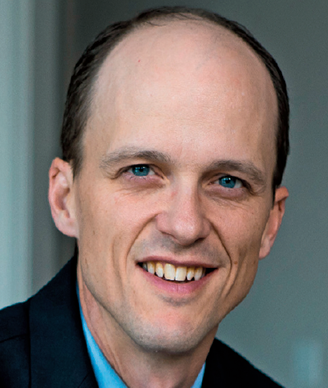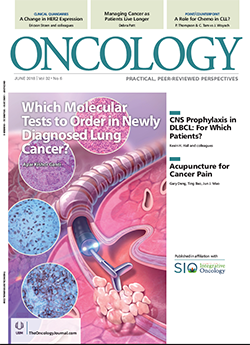How LGL T-Cell Leukemia at 19 Gave Me Empathy for My Patients-and My Colleagues
Late last year, ONCOLOGY hosted a writing contest on Cancer Network, in which we asked our readers to share their personal experiences with delivering bad news. Dr. Trevor Bayliss submitted a piece about his experience as a young patient, and how that influenced his decision to become an oncologist.
Oncology (Williston Park). 32(6):282-3.

Trevor J. Bayliss, MD

Late last year, ONCOLOGY hosted a writing contest on Cancer Network, in which we asked our readers to share their personal experiences with delivering bad news. The Editors-in-Chief of the journal-Dr. Nancy E. Davidson, Dr. Nora Janjan, Dr. Julie M. Vose, and Dr. William C. Wood-judged the entries based on whether they provided a clinical lesson; offered perspectives from both the doctor and patient; were eloquently written and descriptive, and would have an impact on a wide audience of oncology professionals. An essay written by Trevor J. Bayliss, MD, was selected as the runner-up winner and is shared below. (The first place winning essay, by Eileen Parkes, MD, PhD, Academic Clinical Lecturer at the Centre for Cancer Research and Cell Biology at Queen’s University Belfast, United Kingdom, was published in the March issue of ONCOLOGY).
Dr. Bayliss is a medical oncologist and hematologist practicing at Berkshire Health Systems in Pittsfield, Massachusetts. At 19 years old he was diagnosed with LGL T-cell leukemia. After emerging from this experience as a patient, he set himself on a dedicated path to becoming an oncologist in order to help others facing serious illness. He is the Director of Integrative Medicine at Berkshire Health Systems where he channels his passion for creating and promoting evidence-based complementary therapies as part of his patients’ treatment and recovery plans. He furthers his mission of inspiring and supporting cancer survivors and providers through his website, TrevorBaylissMD.com. In his free time Dr. Bayliss runs, writes, and tries to keep up with his three boys.
***********************************************************************
When I first thought of becoming an oncologist, I was in an airplane 30,000 feet in the air, probably somewhere over Iowa, wearing a nasal cannula attached to an oxygen tank. At that moment I was replaying the events that had unfolded in a Seattle cancer center conference room 3 days prior.
As an 18-year-old college freshman I had been struggling with fatigue and, oddly, a steadily protruding abdomen. By the following summer the fatigue was making it hard to get off the couch and I finally presented to my primary doctor. The workup gradually unfolded. I was anemic. My spleen was massively enlarged, thus the protruding abdomen. A bone marrow biopsy was performed with the nurse practitioner standing on a chair for better leverage, while grunting like someone doing arm curls, and commenting between breaths on my “young healthy bones.”
After seeking both a second and third opinion, I finally received the diagnosis: large granular lymphocytic (LGL) T-cell leukemia. The first step was splenectomy. I still remember in the postoperative haze, my strange sense of pride when the seasoned Boston surgeon informed me it was the largest spleen he had removed. A “watch-and-wait” period followed, during which I continued sophomore year of college and began to believe life might return to “normal” again. However, as I entered my junior year, the familiar fatigue crept back, then shortness of breath, followed by comments from well-intentioned peers on my lips looking blue. Finally, on a crisp New England day in the fall I found myself at the top of a single flight of stairs in my dorm, hands on my knees, unable to catch my breath.
With a normal-appearing chest CT, but clearly abnormal pulmonary function test, a lung biopsy was needed. It demonstrated a diffuse infiltration of the clonal leukemic cells, and a liver biopsy for evaluation of abnormal liver function tests showed the same. In an instant the disease that was supposed to be indolent was deemed to be aggressive. The new plan implemented the following week was CHOP chemotherapy (cyclophosphamide, doxorubicin, vincristine, and prednisone)-which, given my age, was to transition directly into an unrelated allogeneic stem cell transplant. We chose Seattle for the transplant, and after I had received several cycles of CHOP at home, my mother and I flew across the country and moved into a small apartment next door to the cancer center. Chemotherapy continued and then was escalated to DHAP (dihydroacetone phosphate). One day, after I had just walked into the cancer center, my vital signs were taken abruptly, and bit of a commotion ensued. An oxygen mask was promptly placed onto my nose. I was directed to wear it around the clock, but I was selective in its use. I toured the transplant unit, the room where I would undergo the total body irradiation procedures. A bone marrow biopsy was repeated, other tests were completed, and 1 week prior to the scheduled transplant date my oncologist called a meeting.
It was one of the only beautiful, sunny days during an otherwise rainy month of April in Seattle. The year was 1997. Flowers were blooming. I remember the sun coming through the conference room window. The space in the small room was taken up mostly by a large square table. I walked around the table and sat near the window to look outside and feel the warmth of the sun. My mother sat to my left. After we had waited for about 10 minutes, the doctor entered the room, accompanied by a nurse. They sat across the table. I’m not sure if it was the distance between us or the minimal eye contact from them, but I quickly sensed that the outlook was not good. Of course, any rationally thinking patient would have realized there was bad news coming. The signs were glaring, including the profound fatigue and the need for supplemental oxygen. But what 20-year-olds imagine that their treatment won’t work, that they will die of their illness? The doctor launched into the battery of testing that had been done and the evidence that the leukemia had not responded. She paused, “there is a 95% chance you would die from the transplant itself.” She had just told me that my only chance was no longer an option. A silence hung in the room and my throat felt tight. I was able to ask, “In your medical opinion, how long do I have to live?” She replied that I had only “months” left, and with her gaze dropping to the table, she added, “maybe weeks.” My mother asked if there were other options. The doctor mentioned more high-dose chemotherapy, but said that it would be unlikely to help. With the last sentence I could get utter, I turned to my mom and told her, “We need to go home.”
Three days later we were flying home. I replayed details of the events in the conference room over in my mind, the words that were spoken, how they were delivered. I replayed the nonverbal details, the setup of the room, the physical distance between myself the doctor, her facial expression, and her lack of sustained eye contact. With these images swirling in my head, a strange thought emerged. I considered ways that my doctor could have handled the situation better. I imagined her coming around to my side of the table and sitting next to me, looking me in the eye, maybe touching my shoulder. Heck, even as a 20-year-old guy, I might have been glad to get a hug. The pain of what was being said would not have changed, but the wounds would not have been as deep. I would not have left the cancer center feeling alone and isolated. On that plane ride home, I imagined that, perhaps if some miracle occurred to save my life, I would dedicate myself to pursuing medicine, becoming an oncologist, sharing these moments with other survivors, and doing a fine job of caring for patients with cancer.
Upon returning home I met with my hometown oncologist and relayed this story. He sat directly in front of me with no table between us, looked me directly in the eye, and said, “Gee, you don’t look that sick!” He found a realistic thread of hope in that moment and offered it to me with those simple words and his expression. He had spoken with the expert in LGL leukemia, and some promising results had been seen with low-dose methotrexate. Within 3 months of starting this treatment, I was in a hematologic remission! I finished college as the seed of the idea that came to me on the plane while returning home from Seattle began to germinate.
As a practicing oncologist more than 20 years later, my view of that April 1997 day in the conference room has taken on new perspective. I see the moment through the vantage point of my Seattle oncologist. Now, when I play it over again in my mind, I can literally feel her pain. She was probably afraid she would cry herself if she looked at me too long or sat too close to me, which I would like to tell her now would have been okay. I have developed a deep empathy for my Seattle oncologist. In my own practice over the years, I have felt viscerally just how difficult it is to deliver this kind of news. Despite my own experiences as a cancer patient, I still have had my own days when I leave the examination room thinking, “I could have done that better.” I am humbled on a daily basis to be with people battling these diseases, and I continue to try to grow as an oncologist.
